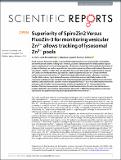Superiority of SpiroZin2 Versus FluoZin-3 for monitoring vesicular Zn²⁺ allows tracking of lysosomal Zn²⁺ pools
Author(s)
Han, Yu; Goldberg, Jacob Michael; Lippard, Stephen J.; Palmer, Amy E.
Downloads41598-018-33102-w.pdf (4.655Mb)
Terms of use
Metadata
Show full item recordAbstract
Small-molecule fluorescent probes are powerful and ubiquitous tools for measuring the concentration and distribution of analytes in living cells. However, accurate characterization of these analytes requires rigorous evaluation of cell-to-cell heterogeneity in fluorescence intensities and intracellular distribution of probes. In this study, we perform a parallel and systematic comparison of two small-molecule fluorescent vesicular Zn²⁺ probes, FluoZin-3 AM and SpiroZin2, to evaluate each probe for measurement of vesicular Zn²⁺ pools. Our results reveal that SpiroZin2 is a specific lysosomal vesicular Zn²⁺ probe and affords uniform measurement of resting Zn²⁺ levels at the single cell level with proper calibration. In contrast, FluoZin-3 AM produces highly variable fluorescence intensities and non-specifically localizes in the cytosol and multiple vesicular compartments. We further applied SpiroZin2 to lactating mouse mammary epithelial cells and detected a transient increase of lysosomal free Zn²⁺ at 24-hour after lactation hormone treatment, which implies that lysosomes play a role in the regulation of Zn²⁺ homeostasis during lactation. This study demonstrates the need for critical characterization of small-molecule fluorescent probes to define the concentration and localization of analytes in different cell populations, and reveals SpiroZin2 to be capable of reporting diverse perturbations to lysosomal Zn²⁺.
Date issued
2018-09Department
Massachusetts Institute of Technology. Department of ChemistryJournal
Scientific Reports
Publisher
Springer Nature
Citation
Han, Yu, Jacob M. Goldberg, Stephen J. Lippard, and Amy E. Palmer. “Superiority of SpiroZin2 Versus FluoZin-3 for monitoring vesicular Zn²⁺ allows tracking of lysosomal Zn²⁺ pools.” Scientific Reports 8, 1 (October 2018): 15034 © 2018 The Author(s)
Version: Final published version
ISSN
2045-2322
Collections
The following license files are associated with this item: